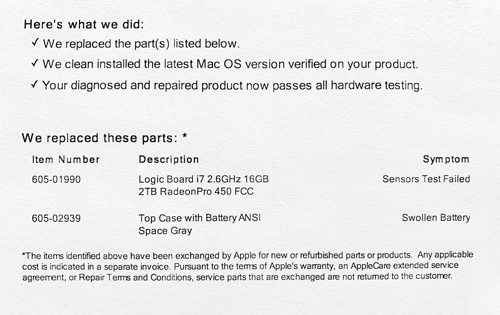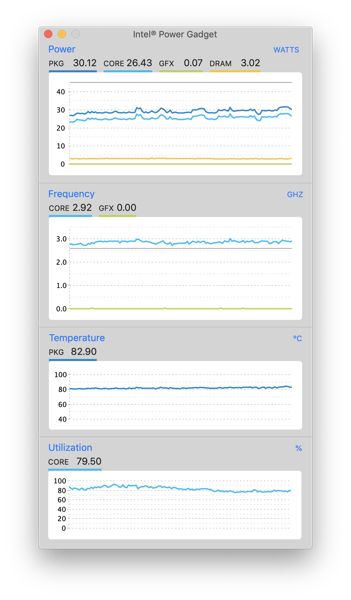When last we left our hero, she was lovingly packing her 2016 MacBook Pro into a box to ship back to Apple for repairs. At the very least we knew that the battery needed service (as verified by Apple in a hardware diagnostic they conducted over the inter webs), and we knew that the keys were doubling. Neither of these two problems seemed to be related to the Max Headroom, video glitching, processor slowdown nightmare that has been the last two months of my life.
Speaking of the last two months, when I was on Daily Tech News Show the other day, Tom Merritt referred to my video streaming woes as being “the crossover event of the summer!” He explained that he had heard me talking about it on my show, then he heard me talking about it on SMR Podcast with Robb Dunewood, and then he heard it on his own show. Heck, he hadn’t even heard Dave Hamilton talking about it on the Mac Geek Gab!
I took my beloved MacBook Pro to FedEx on Sunday afternoon. They shipped it to Apple on Monday morning, by Tuesday morning I got a notice from Apple that repairs had begun, and by Tuesday afternoon I got another notice telling me it was on its way back to me already! Tuesday evening I got a notice from FedEx telling me I was getting a package requiring a signature by 10:30am on Wednesday. At 10:20am, my doorbell rang and my beloved was back. That was simply the fastest repair I have ever experienced in all my years of dealing with Apple!

I was very intrigued to read the repair list of what they found. They replaced the Logic board, including the 16GB of RAM, the 2TB SSD, and the RadeonPro graphics card. And the top case (which includes the keyboard) and the battery. A more efficient way to describe the repair might be to say that they didn’t replace the screen and bottom part that sits on the table with the little feet. And maybe the fans.
I want to point out that I bought this machine in November of 2016 when they were first announced, and paid $239 for AppleCare. A logic board replacement from Apple is between $5-800, and I’m guessing since mine had the 2TB SSD in it, they’d have gone high end for me. The battery replacement would have been $200. I’m not even going to count the $800 the top case costs to replace since that warranty repair is available to everyone for 4 years.
So if I’d had to pay for this repair myself, I would have been out $1000 (at least). I paid $239 for AppleCare. I’m a huge believer in AppleCare and this isn’t the first time I’ve had this kind of proof that it’s a good deal.
Clean Install time
You’ll notice I mentioned that they replaced the SSD, which means I get to do a clean install. Now most people would look at this with dread, but I was really, truly hoping they would make me do this. It’s like how painting our house last year forced me to clean out my closet. It’s a GOOD thing.
I dusted off my iThoughts Mind Map from the last time I did a nuke and pave and got to work. I’m soooo glad I document this every year. It helps in several ways. First and foremost, since I organize the apps to install into three categories, Mission Critical, High Priority and Low Priority, I don’t have to make any decisions on what to install first.
Secondly, I have a parallel set of nodes for tasks, also sorted into Mission Critical, High Priority and Low Priority. These tasks remind me of the kinds of little tweaks and configurations I need to do in order to be as productive as possible. I give future me tips on where settings are saved in some obscure library file, or specific instructions for those things I have to do manually.
I was caught off guard this time when I had to face the fact that I’m a a serious geek now. It creeps up on you when you don’t see it coming. My favorite example of this was when I remembered that I wrote my own mp3 encoder and ID3 tag editor. That was a fun adventure and I use it every single week to create the artwork and tags for Chit Chat Across the Pond.
In my mind map it tells me to go grab the script from a backup. And then I tried to remembered that it uses an open source library called ffmeg to transcode the m4a audio file to an mp3. But I can’t install ffmpeg from the command line in Terminal until I install home-brew from the command line, right? I’m a nerd and so proud of myself for it and so happy Bart has been my muse over all these years to get me here.
I added one app to my Mission Critical list, and that’s Copy’em Paste that I told you about last week. I’ll give you an example of why it’s so critical to me now. I use MarsEdit for my blogging tool and I’ve created a bunch of slick automations in it, specifically the ones that let me format images in the posts, like the ones with pretty captions. I could have bothered the developer, Daniel Jalkut to ask him where the preferences are, and that would have been great fun, but I found an easier way to transfer all of the crazy code that makes it possible. On my 2013 MacBook Pro, I simply copied each field one after another ⌘-C, → over and over again.
Since I coughed up the grand total of $5 for iCloud syncing of Copy’em Paste, on the 2016 MacBook Pro I was able to open up the same fields in MarsEdit and used Copy’em Paste to paste each item in. It was sweet! I also found that in a lot of cases, Apple’s built-in Continuity helped me copy from one Mac and simply paste into the other Mac.
Another surprise in going through this so far is that other than pulling Library configuration files, I’ve not yet actually moved any data from my backup drive.
- About a year ago I decided to finally turn on iCloud syncing of my desktop and documents, and that’s turned out to be super useful. I’ve got most of the important stuff for the podcast in my Documents folder so it’s been pretty seamless
- I installed Dropbox which I use to move some kinds of config files between computers, and also has my synced iThoughts files.
- I use Google Drive for sharing files with Steve, like all of our vacation documentation so that’s been synced right over.
- Of course I use iCloud Photo Library for my photos, which means that yet again, I’m now downloading 77,000 photos from iCloud. That goodness I have good bandwidth!
I’m actually wondering what’s on that backup drive anyway, since I’m working away without needing any data from it!
But What about That Pesky Video Problem?
There’s a few of you out there who are yelling at your devices right now saying, “After 1200 words you still haven’t mentioned your video streaming problems???”
As of last week, I had determined to a 67.3% certainty that the root cause was the LG 5K display. I based this on the fact that I was able to conjure up Max Headroom on both the 2016 MacBook Pro and the 2013 MacBook Pro with the LG 5K but not with the elderly Apple Cinema Display. But hold that thought…
After I had installed all of my mission critical apps on the newly-repaired 2016 MacBook Pro and done all of the fiddling with settings to make them do my bidding, it was time to do some tests. I noodled all of the changes I could make to the system to start testing scenarios. But then I thought, what if I just put the system back exactly the way it used to work before suddenly things went wonky?

I plugged all of my peripherals into the CalDigit TS3+ Thunderbolt 3 dock first: Logitech webcam, Shure microphone interface, and headphones. I connected the 5K display to the dock using a Thunderbolt 3 cable. Then I connected the 2016 MacBook Pro to the dock again using a Thunderbolt 3 cable. This configuration means video, audio, data and power are all being sent back and forth using a single Thunderbolt 3 port on the Mac.
I launched all of my video and audio recording software using the script I created for this purpose. That’s Hindenburg for recording the podcast, Audio Hijack to capture and sweeten my voice, Loopback to route my voice and Hindenburg into virtual audio sources, Webcam Settings to manage my webcam, Chrome open to a mimoCall URL to send my video and audio to Steve, and finally NDI Scan Converter to capture my Hindenburg window to send that to Steve’s mimoLive session.
This is the exact configuration that began going belly up a month ago, where my video would start to get out of sync with my voice and eventually become very jerky. This is when watching my processor using Intel Power Gadget would show me it had dropped from 2.7GHz down to as low as 1GHz. It also showed the thermal sensor on the CPU was reporting only 60°C which is actually pretty low.
We did our test and, wait for it … nothing went wrong! No voice/video sync issues, no Max Headroom-like jerkiness to my video, no dropping of the processor frequency. Everything was perfectly fine. Intel Power Gadget confirmed the findings, showing that my CPU was happily idling along at 3.8GHz, even though the CPU die sensor was now reporting 83°C. Remember the repair report said that the sensors had failed their test. Maybe when it was reporting 60°C it was just making that number up and had no idea how hot things actually were in there.
Is it possible that the Mac disintegrating in so many ways was the root cause of all the problems? Could it explain why we had so much trouble finding a controlled experiment that had consistent results?
Two questions remain outstanding and they’re kind of related. When I was convinced it was the 5K monitor, I came to that conclusion because swapping out the entire Mac for the older one gave me the same results. It’s a stretch to say I can completely explain this result but with the help of a lot of people I’ve got a theory.
The 2013 MacBook Pro doesn’t have Thunderbolt 3, it’s only got Thunderbolt 2. The Apple Cinema Display I was using to replace the 5K display was pre-Thunderbolt, so it only has DisplayPort. In addition, the Apple Cinema Display is lower resolution so it was sending required far less data transfer than a 5K display. That means the setups without the 5K display were less taxing for both computers.
As I said, the older Mac does speak Thunderbolt, just Thunderbolt 2 instead of 3. When I connected that older Mac through the dock to the 5K display, it’s possible that driving the display was just too much for that computer to accept, including all of the data from the other peripherals.
I’d love to have a more specific answer to the older Mac having problems but I’m now up to 83.4% certain that the root cause of my video streaming woes was that my 2016 MacBook Pro was disintegrating. I truly, dearly hope that there will not be a follow up to this story.


Fingers crossed that this is a permanent fix! I’ve only had to send away a Mac once, but it came back just as quickly as yours did — terrific service, and one of the reasons I swear by (not *at*) AppleCare.
The folks at AppleCare must really think that you push ALL your devices to the limit. I wonder if they have a tally on the wall of your iPad Pro and Keyboard returns cross-referenced to your MacBook issues, not counting the iPhone case issues.
I can’t think of a better advertisement for getting AppleCare.